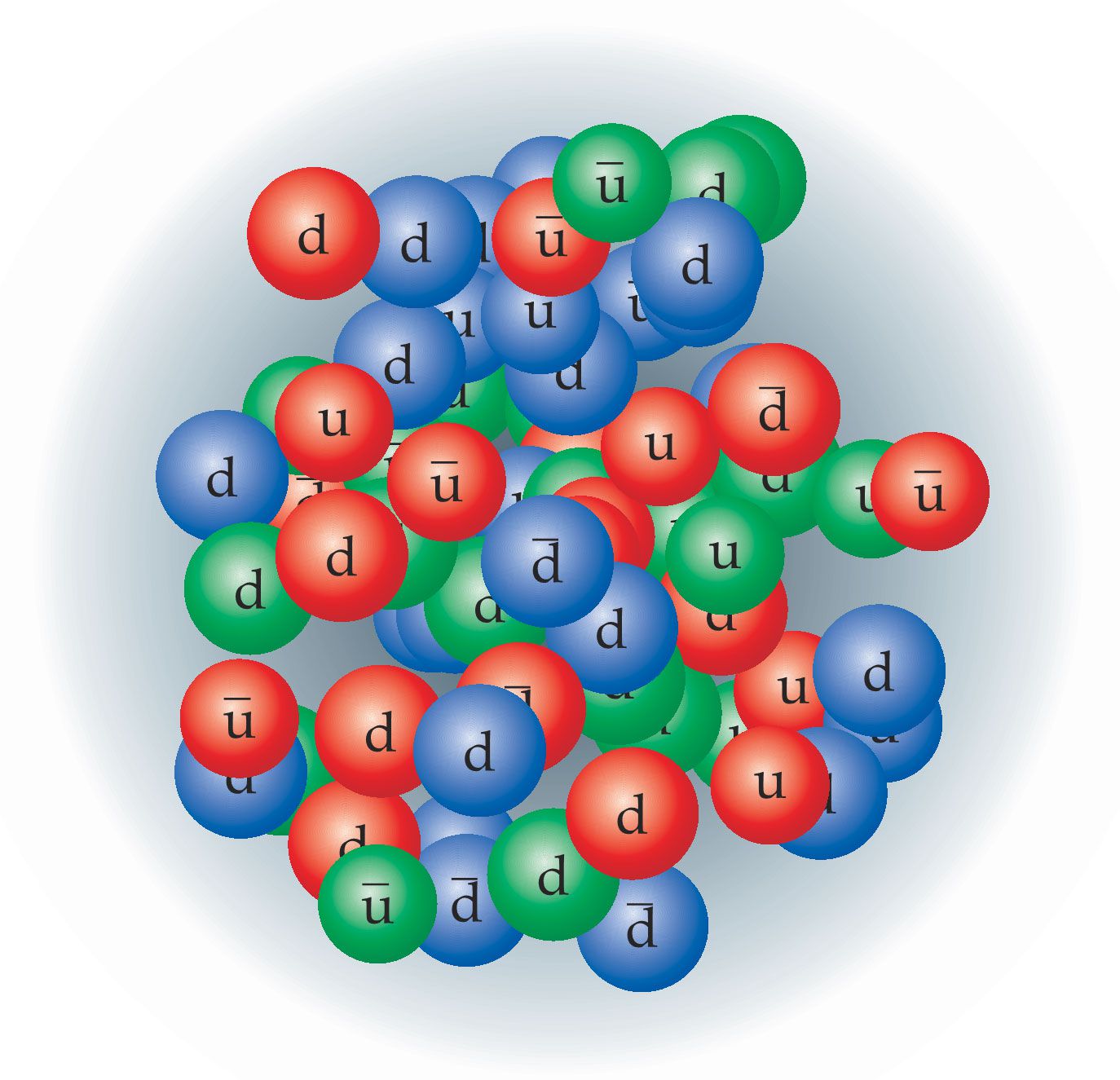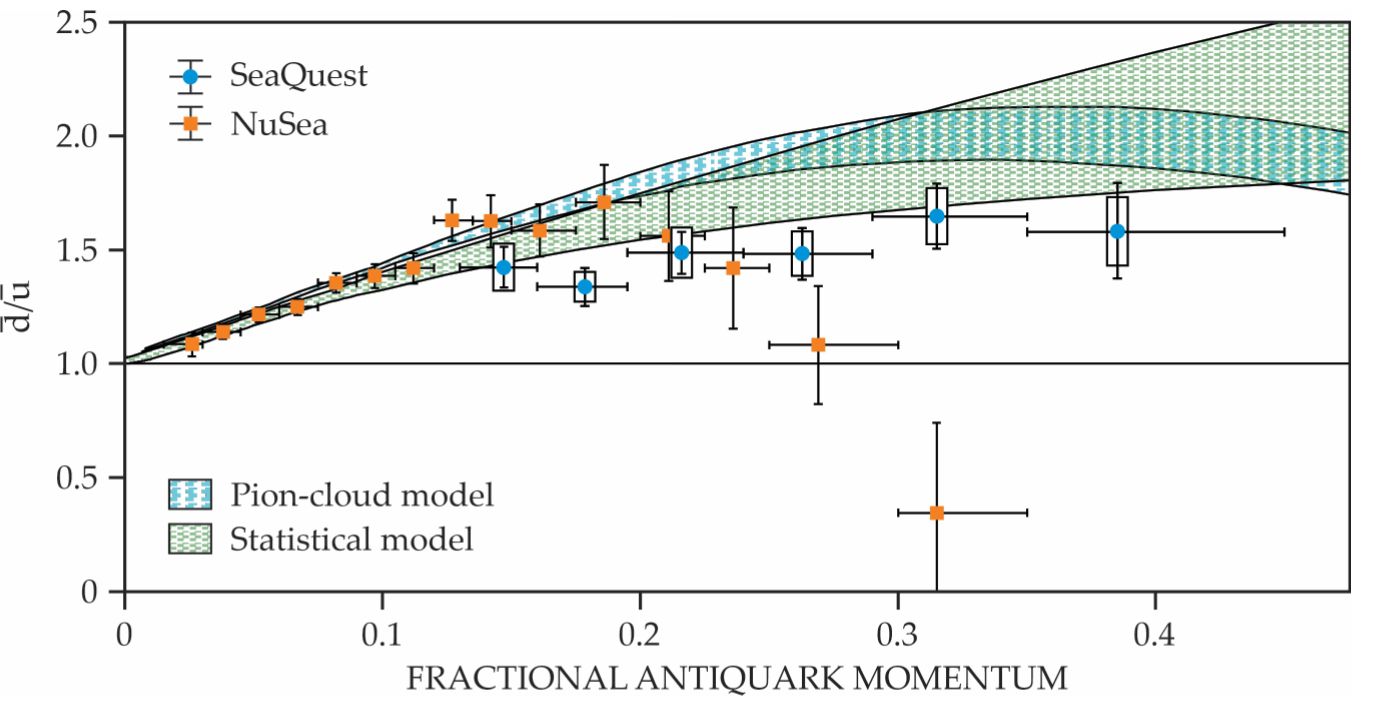A new look at the proton sea
DOI: 10.1063/PT.3.4743
Students of particle physics learn early that the proton is made of three quarks: two up and one down. But there must be more to the story than that. The proton’s rest mass is 938 MeV. The three quarks, with masses of just a few MeV each, make up only a tiny fraction of that.
Where does the remaining mass come from? Much of it is the kinetic energy of the quarks—they’re not at rest inside the proton, and special relativity dictates that their effective mass increases with speed. Most of the mass lies in the details of how the strong force holds the proton together.
Gluons, the carriers of the strong force, are themselves massless, but the energy of the gluon field contributes to the total proton mass. And the field can spawn fleeting pairs of quarks and antiquarks, known as the sea, as represented in figure
Figure 1.

The proton comprises not just two up quarks and a down quark but also a roiling sea of quark–antiquark pairs. The sea, which can’t be accurately modeled by perturbative quantum chromodynamics, is an integral part of the proton’s makeup and challenges theorists’ understanding of how the strong force works. (Adapted by Donna Padian from an image by Paul Reimer.)

At the energy scales encountered in everyday life, protons behave like self-contained particles, and the sea and the rest of their internal structure are mostly irrelevant. But at the high energies of particle accelerators, the reactions produced by a proton–proton collision really stem from collisions between the protons’ component particles. Understanding the sea thus makes it possible to better predict what proton–proton colliders are capable of.
Now the SeaQuest experiment at Fermilab has released the results of the most thorough analysis of the sea to date.
1
The collaboration found that
Blow ye winds
The key to navigating the sea is to identify a particle reaction that could result only from sea quarks, not the original three valence quarks. In a collision between some combination of d and u quarks, there’s no distinction between valence and sea quarks. But a collision that involves antiquarks must involve the sea. (Quarks of other flavors, such as strange and charm, also occasionally show up in the sea, but they’re not SeaQuest’s focus.)
One reaction for homing in on the sea antiquarks is the Drell–Yan process: In a pair of colliding protons, a quark from one annihilates with an antiquark from the other to produce a virtual photon, which promptly decays into a muon and antimuon.
An experiment to study the sea through the Drell–Yan process typically shoots a beam of high-energy protons into a stationary target made of liquid hydrogen; the muon–antimuon pairs keep traveling in the original direction of the beam, where they’re then detected. That configuration is most sensitive to collisions involving antiquarks from the target and quarks from the beam, rather than the other way around. So by swapping between targets made of hydrogen and deuterium, the experimenters can measure the difference between the antiquark seas of the proton and the neutron—and thus, with some symmetry assumptions, the
Some 20 years ago, SeaQuest’s intellectual precursor—NuSea, also at Fermilab—used that approach to study the sea.
2
The results, shown in orange in figure
Figure 2.

The composition of the proton’s quark sea, characterized by the ratio between the numbers of down and up antiquarks, was probed 20 years ago by NuSea

Across the line
That there should be any difference at all in the
To explain the
Another idea, developed by Seattle University’s Mary Alberg and the University of Washington’s Gerald Miller, represents the sea quarks as a cloud of pions and other mesons that appear and disappear around the proton: At any given instant, the proton might really be a neutron (ddu) plus a positively charged pion (
The theories can explain the overall
NuSea was unable to help resolve the mystery. Its
Go to sea once more
Right away, the idea emerged for SeaQuest, a purpose-built experiment designed to detect events from high-fractional-momentum antiquarks, but the fruition of the project was long in coming. “The first proposal was in 1999,” explains Reimer, “but Fermilab wasn’t in a position to run the experiment at that time, so very little work was done until about 2009. The experiment was commissioned in 2012, and data collection ran from 2013 until 2017.”
By then, Fermilab’s Tevatron, whose 800 GeV proton beam supplied the protons for NuSea, had been shut down. SeaQuest’s only option was to use the 120 GeV protons from the lab’s main injector, which remains operational. But the energy reduction was actually an improvement: The Drell–Yan cross section is inversely related to the collision energy, whereas cross sections for various background processes are directly related to energy. Put all together, then, SeaQuest was almost 50 times as effective at studying sea quarks as NuSea was.
A major experimental challenge—and a big part of why SeaQuest’s data analysis has taken so long—came from the fluctuating intensity of the main injector beam. To detect Drell–Yan events, researchers comb their data for muons and antimuons whose timing and speed indicate that they were produced in the same place at the same time. If too many protons arrive at the target at once, there’s a chance that particles produced in separate reactions could look like they came from the same Drell–Yan event.
“We could have just thrown away all the data from when the beam intensity was too great,” says Reimer, “but then we would have lost a lot of our statistics. So we had to find a way to deal with it and extrapolate down to what we would have seen at low intensity.”
The results just released, shown in blue in figure
Should the NuSea data thus be superseded by the more easily explained SeaQuest data? Reimer is hesitant to go that far. “We’ve found no reason to think that either data set is incorrect,” he says. “All I can say is that the NuSea data are on the very edge of that experiment’s acceptance, whereas SeaQuest was designed to study this region.”
In search of more clues, SeaQuest is transforming into SpinQuest. The new experiment will study collisions of beam protons with spin-polarized targets, in the hope of better understanding how the proton gets its spin. The proton spin contains contributions from the spins of all the valence and sea quarks, all of their orbital angular momenta, and the gluons holding everything together. So why, with such an ever-fluctuating ensemble of components, is the proton’s spin always ½?
References
1. J. Dove et al., Nature 590, 561 (2021). https://doi.org/10.1038/s41586-021-03282-z
2. R. S. Towell et al. (FNAL E866/NuSea collaboration), Phys. Rev. D 64, 052002 (2001). https://doi.org/10.1103/PhysRevD.64.052002
3. M. Alberg, G. A. Miller, Phys. Rev. C 100, 035205 (2019). https://doi.org/10.1103/PhysRevC.100.035205
4. E. Basso et al., Nucl. Phys. A 948, 63 (2016). https://doi.org/10.1016/j.nuclphysa.2016.02.001
